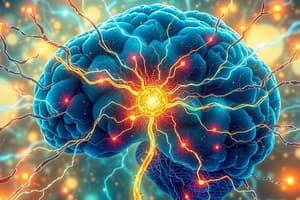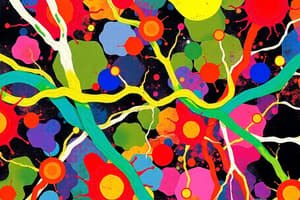Podcast
Questions and Answers
What is the primary function of the presynaptic neuron?
What is the primary function of the presynaptic neuron?
To synthesize, transport, and store neurotransmitters.
What process occurs to release neurotransmitters?
What process occurs to release neurotransmitters?
- Membrane fusion and exocytosis (correct)
- Osmosis
- Endocytosis
- Diffusion
Autoreceptors are present on the postsynaptic neuronal membrane.
Autoreceptors are present on the postsynaptic neuronal membrane.
False (B)
What determines receptor activity?
What determines receptor activity?
Neurotransmitter action may be controlled at various points, including __________ regulation.
Neurotransmitter action may be controlled at various points, including __________ regulation.
Which category of receptors alter the probability of opening transmembrane pores?
Which category of receptors alter the probability of opening transmembrane pores?
What ion enters the cell due to the action of inhibitory neurotransmitters?
What ion enters the cell due to the action of inhibitory neurotransmitters?
Which of the following is NOT a method of neurotransmitter cessation?
Which of the following is NOT a method of neurotransmitter cessation?
Flashcards are hidden until you start studying
Study Notes
Synaptic Transmission
- Neurotransmitters are synthesized in the soma, transported through the axon, and stored in synaptic vesicles at the terminal.
- Release of neurotransmitters occurs through membrane fusion and exocytosis.
- Neurotransmitters bind to receptors on postsynaptic membranes and autoreceptors on presynaptic membranes.
- Autoreceptor activity regulates neurotransmitter synthesis and release through feedback inhibition.
- Neurotransmitters exhibit specificity in receptor interaction, with one neurotransmitter potentially binding to multiple receptor types.
- Receptor binding is often competitive, with the relative concentration of neurotransmitters influencing receptor activity.
- Most receptors are bound reversibly, while some molecules can bind irreversibly, causing structural alterations in the receptor complex.
- Cessation of neurotransmitter action occurs through reuptake, enzymatic breakdown, and removal by glia or plasma circulation.
Feedback Control of Neurotransmitter Activity
- Control of presynaptic synthesis, regulation of release, reuptake regulation, autoreceptor-mediated presynaptic inhibition, and independent postsynaptic inhibition via a different neuronal network.
Classification of Receptors
- Ligand-gated Channels (ionotropic): Binding of a chemical messenger alters the probability of opening transmembrane pores or channels, resulting in fast responses (e.g., GABAA benzodiazepine).
- G Protein-coupled Receptors (metabotropic): Receptors are coupled to intracellular G proteins, leading to a slower response (e.g., most antipsychotics, antidepressants).
- Ligand-dependent Regulators of Nuclear Transcription (nuclear receptors): These receptors directly influence gene expression.
Ionotropic Receptors
- Ion channel receptors are composed of four or five protein subunits forming a pore-like structure.
- The GABA-A receptor is a typical example, resembling a "doughnut with a hole in the center" or a "rosette" shape.
- Each protein subunit consists of a string of amino acids that traverse the cell membrane four times.
- Inhibitory neurotransmitters lead to Cl- entry, while excitatory neurotransmitters result in Ca2+ or other cation entry.
- Ionotropic receptors include GABAA, NMDA, and the 5HT3 subtype of serotonin receptors.
G-protein-coupled Metabotropic Receptors
- These receptors span the cell membrane seven times, forming a "serpentine" structure.
- They initiate a cascade of intracellular signaling events through G proteins.
- These receptors are generally slower acting than ionotropic receptors.
Studying That Suits You
Use AI to generate personalized quizzes and flashcards to suit your learning preferences.




